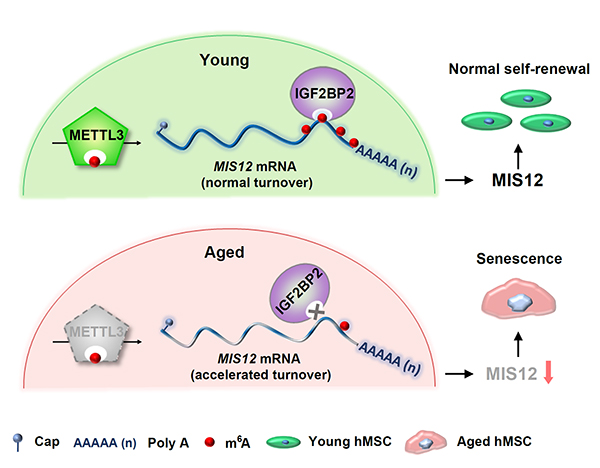N6-methyladenine (m6A) is the most abundant epitranscriptomic modification on messenger RNA (mRNA). The establishment, erasure, and recognition of m6A are dynamically regulated by m6A methyltransferases (writers), demethylases (erasers) and binding proteins (readers), respectively. It has been well known that m6A modifications play crucial roles in regulating splicing, transport, stability, and translation of target RNAs. Emerging evidence has shown that m6A modifications impinge on central biological processes such as stemness maintenance and differentiation, adipogenesis, and spermatogenesis and are implicated in pathological processes underlying obesity, infertility, diabetes, neuronal disorders, aberrant immune signaling and cancers. However, the role of m6A RNA modifications in regulating stem cell senescence remains largely unknown.
Recently, scientists from the Institute of Zoology and Beijing Institute of Genomics of the Chinese Academy of Sciences have collaborated jointly to unveil a novel mechanism of METTL3 as well as m6A in regulating human stem cell senescence. This study entitled “METTL3 counteracts premature aging via m6A-dependent stabilization of MIS12 mRNA” was published online in Nucleic Acids Research on October 9th, 2020. Using including Hutchinson-Gilford progeria syndrome (HGPS) and Werner syndrome (WS), researchers explored the function of m6A and its core methyltransferase METTL3 during human stem cell aging and revealed that MIS12 functions as a downstream factor of METTL3/m6A in regulating hMSC senescence.
In the study, researchers first found that the levels of both m6A RNA methylations and its METTL3 were reduced during human stem cell aging. Knockout of METTL3 accelerated stem cell senescence whereas overexpression of METTL3 rescued cellular senescence phenotypes. Transcriptional profiling of m6A modifications further identified MIS12, a cell cycle regulator, of which m6A modifications were reduced in both hMSCs and METTL3-deficient hMSCs. Mechanistically, loss of m6A modifications decreased the expression and accelerated the turnover of MIS12 mRNA while knockout of MIS12 accelerated cellular senescence. Furthermore, m6A reader IGF2BP2 was identified as a key player in recognizing and stabilizing m6A-modified MIS12 mRNA; knockdown of IGF2BP2 also accelerated senescence in human stem cells.
Taken together, this study puts forth a regulatory model in which METTL3 and m6A modifications alleviate hMSC senescence through IGF2BP2-mediated enhancement of MIS12 mRNA stability. The existence of a direct molecular connection between MIS12 expression and its m6A level suggests the manipulation of m6A modifications or its core methyltransferase METTL3 as potential strategies for cellular rejuvenation. This work sheds light on the poorly understood molecular mechanism of m6A in aging and identifies METLL3 and MIS12 as potential novel biomarkers and therapeutic targets for aging-associated disorders.

Figure. A model illustrating the protective role of METTL3/m6A in alleviating hMSC senescence through IGF2BP2-mediated enhancement of MIS12 mRNA stability.
Link:
https://academic.oup.com/nar/advance-article/doi/10.1093/nar/gkaa816/5920440
(Contact: Liu Guanghui, ghliu@ioz.ac.cn)

